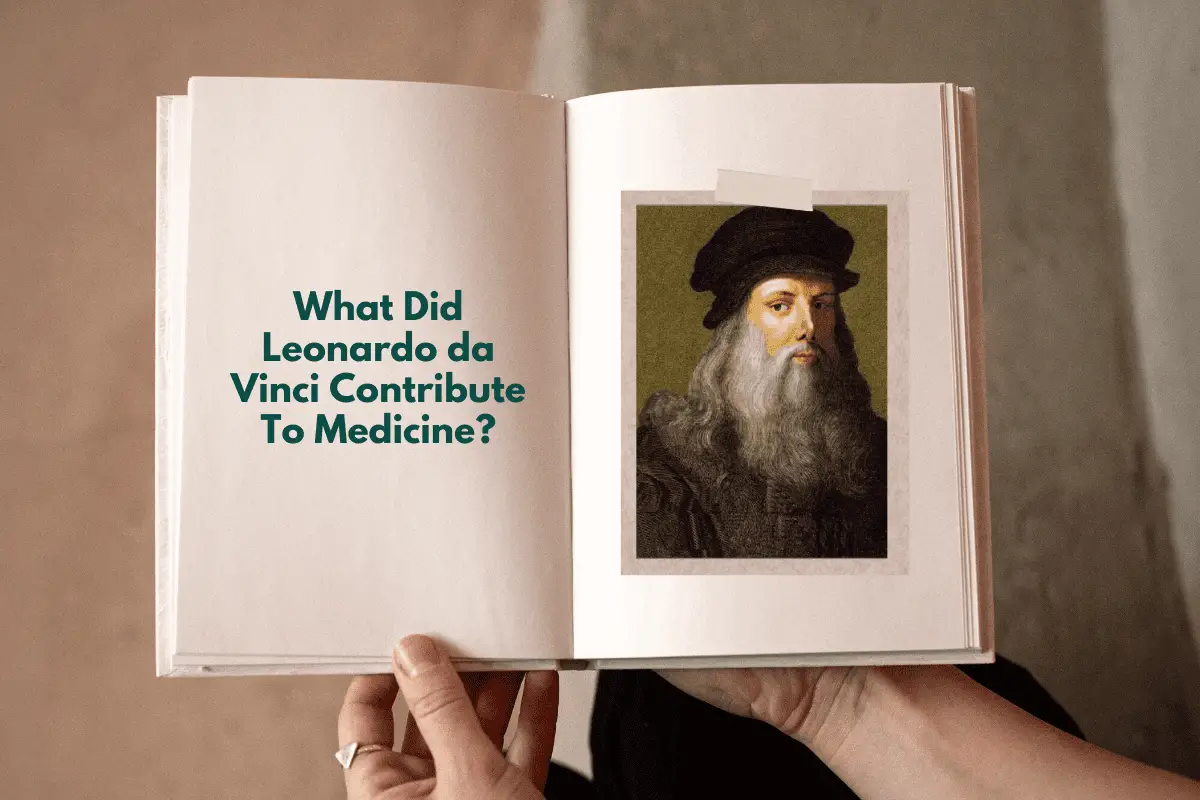One of the most exciting things about Leonardo is that he was a great artist and made many contributions to other fields such as medicine. He combined his artistic skill and medical knowledge to create some fantastic medical drawings.
Leonardo da Vinci contributed a lot to the medical field of study. His work contributed to our understanding of anatomy, medical physics, biomedical engineers, and neuroscience. He was fascinated with the human body as an artist and as a scientist.
Table of Contents
Leonardo’s Contributions To Medicine
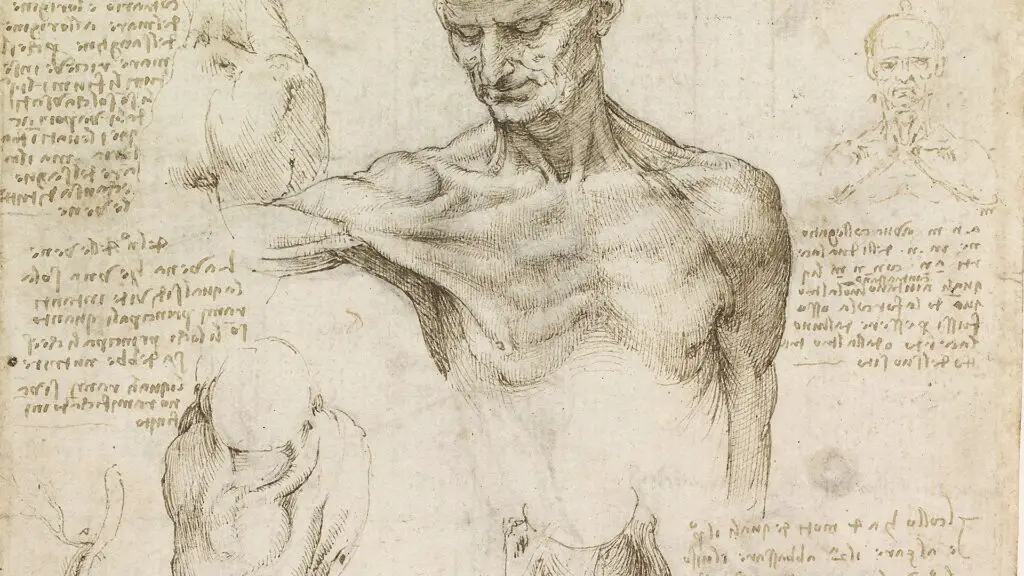
Leonardo da Vinci is known to be someone who contributed not just to the art world but also to other fields, such as anatomy, medical physics, biomedical engineering, and neuroscience – to name a few. Leonardo personally dissected at least 30 human bodies to study the workings of the human body.
His dissections of the human body not only helped Leonardo understand the human form for his many pieces of artwork but also helped him understand science. Many of his scientific findings were written in a notebook; he purposely wrote in a code that needed to be deciphered.
At this time, the church controlled everyday politics. The church felt that this type of study of the human form and the dissection of the bodies was blasphemy and should be punished.
Leonardo hid many of his medical findings, and it was not until centuries later that they were discovered. Some scholars have estimated that if he had been allowed to publish freely and share his findings with others during his lifetime, it would have helped advance medicine during his time by at least a century or more.
Leonardo da Vinci’s Contributions to Anatomy
Leonardo da Vinci was fascinated with human anatomy and how the human body worked. He filled many notebooks with his studies of the human body.
The sketches he made and the fact that he dissected so many bodies show his complete fascination with anatomy and his understanding of how the human body worked. One of the reasons the sketches were so accurate is because he would sketch while dissecting the human bodies.
Leonardo is known to have made many important discoveries about human anatomy. He produced one of the first accurate descriptions of the human spine.
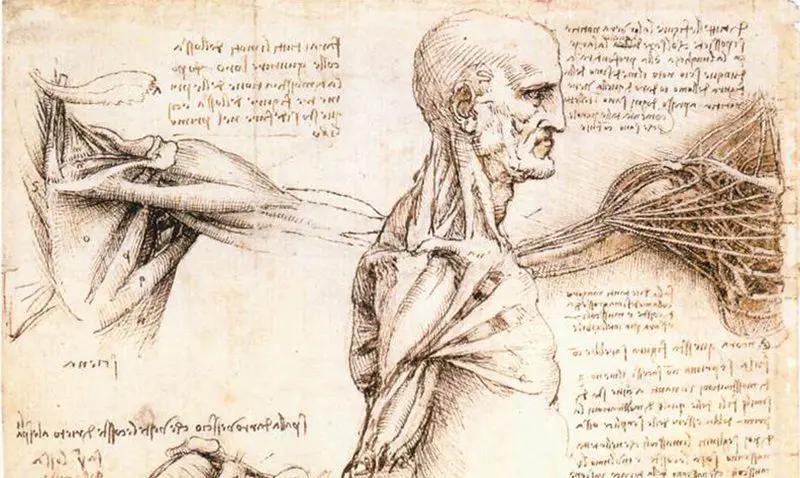
He also made many contributions to understanding the human heart and how the heart operates. Leonardo understood that the heart had four chambers. He also discovered the arterial and filling chambers contract together while the pumping chambers or ventricles were relaxing and vice versa.
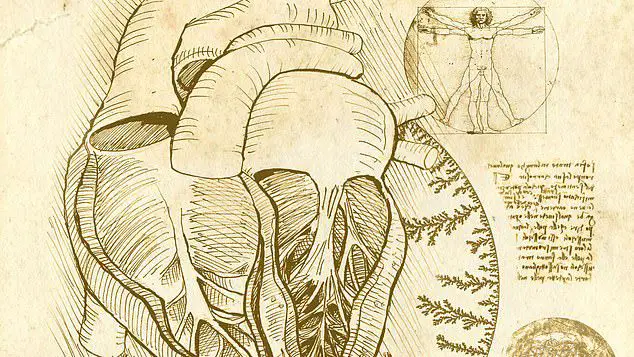
Today, this continues to be a lot of our basis for understanding the human heart and how the heart pumps blood and operates. He also studied and began to understand things as the aorta value.
Many of his sketches of the human body and the human heart are beautiful; they are realistic and atomically correct.
What makes Leonardo so unique and his contributions so important is that he could dissect a human body like a scientist and then put it on paper with the accuracy of a great artist.
Leonardo da Vinci’s Contributions To Medical Physics
Many people consider Leonardo da Vinci to be the first medical physicist. A medical physicist will apply the concepts and techniques of physics to medicine; today, many medical physicists are involved in cancer treatments.
Leonardo spent a lot of time studying all aspects of the human body. He wanted to understand how blood flowed through the body and understand the physiology of the human body; Leonardo looked for insights into all aspects of the human body.
Leonardo’s most significant contribution to medical physics was in optics; the field of optics is the branch of physics that studies the behavior and properties of light. This is not surprising as light and optics are an essential part of art.
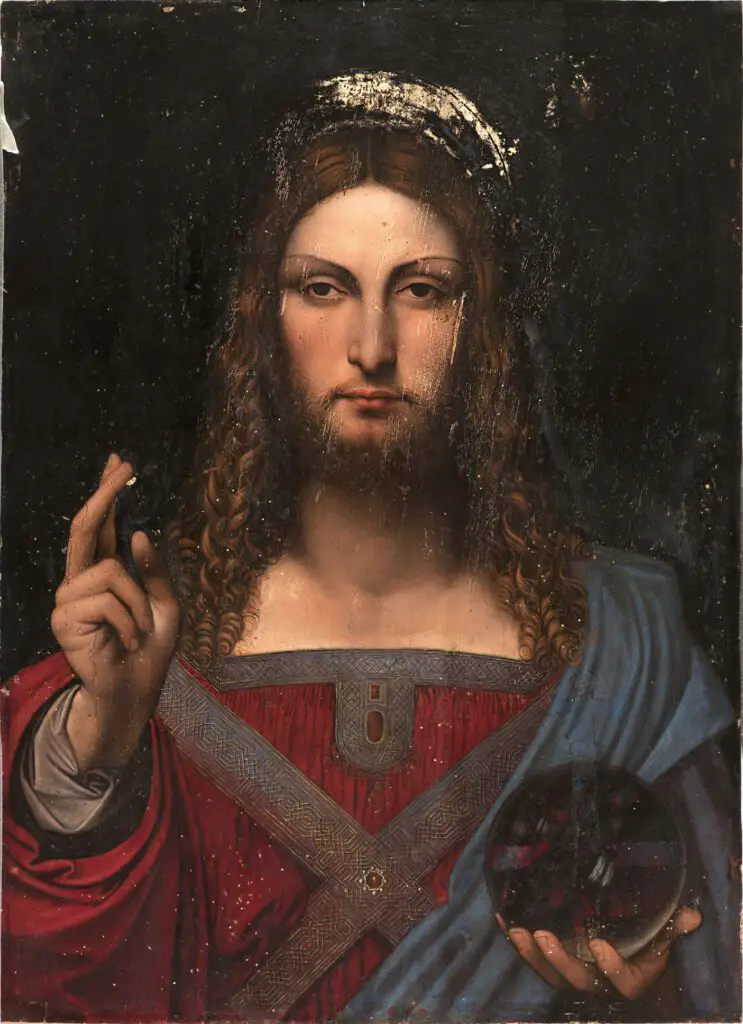
Leonardo wrote about optics and used what he learned in his art. In his painting of Salvator Mundi, you can see his optics focus, particularly the eyes and how he painted them.
Leonardo was known to study the eyes, even boiling eggs to cut them open and comparing them to the human eye. He also dissected many human eyes. He would then document these studies and use the techniques he learned in his paintings.
Leonardo da Vinci’s Contributions To Biomedical Engineering
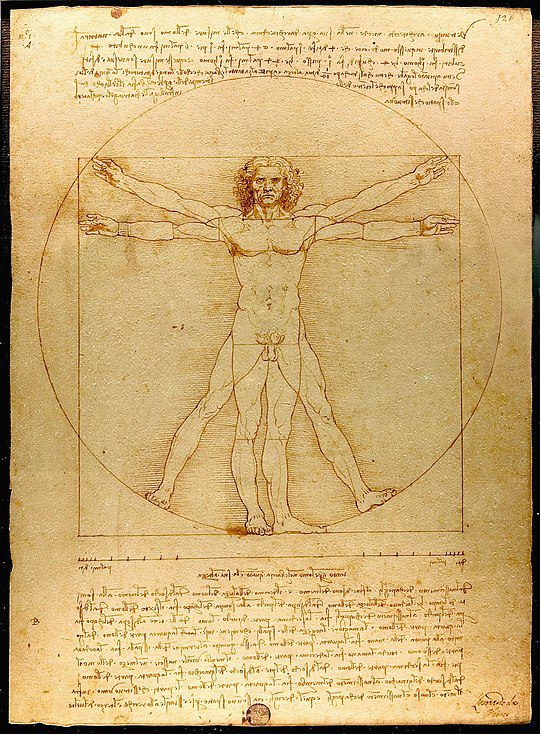
Leonardo da Vinci helped contribute to what we know today as a biomedical engineer. You only need to look at his drawing of the “Vitruvian Man,” which he made in 1490 as one of the world’s most essential and recognizable drawings.
The Vitruvian Man drawing connects the human form and the universe. The purpose of the drawing was to try to show the principles of Vitruvius, a Roman Architect.
In the Vitruvian Man drawing, we can see how Leonardo applied what we know today as biomedical engineering. Biomedical engineering is about applying principles and problem-solving techniques used in engineering from biology and medicine.
One of the main focuses of biomedical engineering is to focus on those things that can advance and improve human health and health care.
The Vitruvian Man shows how Leonardo would try to understand everything around him, from nature to machine inventions. That is why he is considered one of the first people to apply biomedical engineering principles.
Leonardo was one of the first self-taught engineers who tried to understand everything that was going on around him. He studied everything from the nature around him to the machines used.
Leonardo investigated all aspects of the human body and used this study for the basis of his artwork and to methodically write down all of his findings in his notebooks.
Leonardo da Vinci’s Contributions To Neuroscience
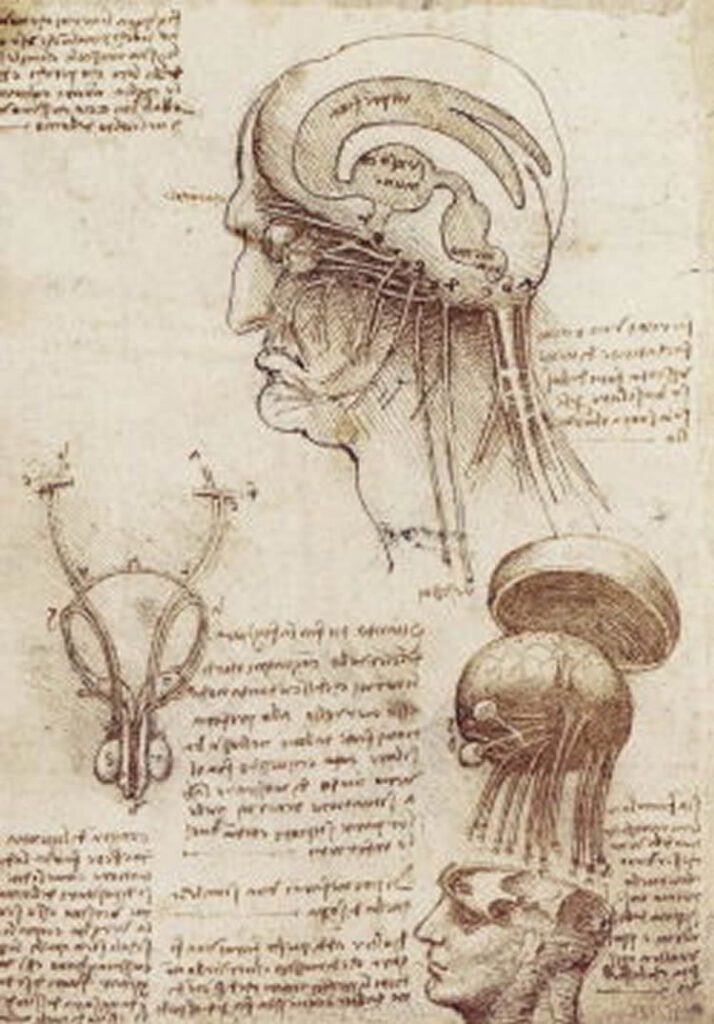
Leonardo da Vinci also spent a lot of time studying the human brain. Today we would call the study of the human brain neuroscience.
His research into the brain led him to discover aspects of medicine such as neuroanatomy, which included the study of the frontal sinus and meningeal vessels and neurophysiology.
Leonardo was considered the first person to pith a frog, a process where the specimen as a frog has a needle inserted near the base of the skull. Once this needle is inserted into an animal like a frog, it can kill or immobilize them.
Leonardo also injected hot wax into the brain of an ox so that he could have a cast of the ventricles. He is one of the first people to try injecting a substance into a body to define and understand the shape and size of the body parts.
Leonardo spent a lot of time studying and understanding the brain and how the brain works. He looked at visual and other sensory inputs into how the brain functions and works.
Leonardo da Vinci was one of these unique individuals who made significant contributions to art, medicine, and other sciences. He contributed to many medical discoveries that we know and understand today.
Anita Louise Art is dedicated to art education, great artists, and inspiring others to find and create their art. We love art that uplifts and inspires. #ArtToMakeYouSmile! #ArtToMakeYouHappy!
If you are interested to see any of my art, you can find out more by clicking here. If you are interested in what inspires me and my paintings, you can discover more by clicking here.
We have a free newsletter and would love you to be part of our community; you can subscribe to the newsletter by clicking here. If you have any questions, I would be happy to talk to you at any time. You can reach me, Anita, by clicking here.
Subscribe to our Anita Louise Art YouTube Channel filled with great videos and information by clicking here.
Join us for our podcast “5 Minutes With Art.” Spend just 5 minutes a week with us to discover and learn about great art and artists. You can find out more about our podcast by clicking here.
Frequently Asked Questions
Who was Leonardo da Vinci, and what was he known for?
Leonardo da Vinci was an Italian Renaissance artist, scientist, and inventor. He is known for his iconic works of art such as the “Mona Lisa” and “The Last Supper.”
How did Leonardo da Vinci contribute to the study of medicine during and after the Renaissance?
Leonardo da Vinci’s work in anatomy and his detailed illustrations of the human body significantly contributed to the study of medicine during and after the Renaissance. He dissected and sketched numerous human and animal cadavers to better understand the human body’s functions.
What medical discoveries did Leonardo da Vinci make?
Leonardo da Vinci made many medical discoveries through his anatomical studies, including the discovery of the human circulatory system and the function of the heart valves.
What is the significance of Leonardo da Vinci’s anatomical drawings?
Leonardo da Vinci’s anatomical drawings are significant because they were some of the most detailed and accurate representations of the human body during the Renaissance. They were instrumental in advancing our understanding of anatomy and physiology
How did Leonardo da Vinci’s artistic skills contribute to his work in medicine?
Leonardo da Vinci’s artistic skills allowed him to create detailed and accurate illustrations of the human body, which were crucial in advancing medical knowledge during the Renaissance.
What is the Vitruvian Man, and what does it represent in the study of medicine?
The Vitruvian Man is a drawing by Leonardo da Vinci that depicts a man in two superimposed positions with his arms and legs apart. It represents the ideal proportions of the human body and was used as a reference for medical illustrations
How did Leonardo da Vinci’s study of optics contribute to medicine?
Leonardo da Vinci’s study of optics contributed to medicine by helping to develop an understanding of how the eye sees and how light affects the human body
What is the connection between Leonardo da Vinci’s study of medicine and his interest in flight?
Leonardo da Vinci’s study of medicine and anatomy influenced his interest in flight by providing him with a deeper understanding of the structure and function of the human body, which he used to design flying machines
Related Questions
What Did Leonardo da Vinci Contribute To The Renaissance?
Leonardo da Vinci made many contributions to the Renaissance in art, science, engineering, medicine, and architecture. He was a keen observer who wrote down a lot of what he discovered in his notebooks. His artistic techniques changed how artists painted and influenced many other Renaissance artists.
By clicking here, you can learn more by reading What Did Leonardo da Vinci Contribute To The Renaissance?.
What Technique Did Leonardo da Vinci Add To The Painter’s Toolbox?
Leonardo da Vinci added the Sfumato technique to the painter’s toolbox. The Sfumato technique is about an artist using a soft transition between the different colors and tones that the artist is using. Many artists, including Leonardo, use this technique on the faces they are painting to give them a more realistic feel.
By clicking here, you can learn more by reading What Technique Did Leonardo da Vinci Add To The Painter’s Toolbox?.

